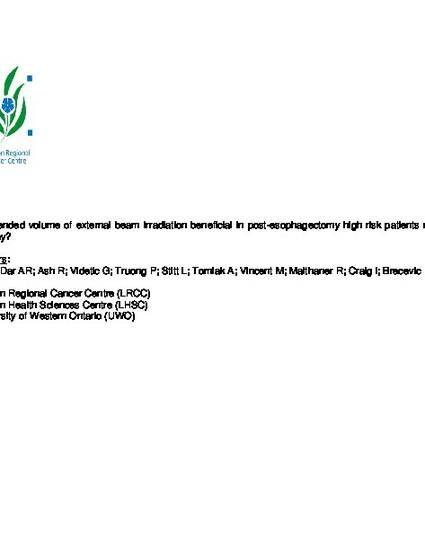
OBJECTIVE: To assess the value of extended volume irradiation with anastomotic coverage in high risk resected esophageal cancer patients.
METHOD: A retrospective study was undertaken at LRCC from 1989-1999 for high risk resected esophageal cancer patients. Adjuvant treatments consisted of 4 cycles of chemotherapy (epirubicin/fluorouracil/cisplatin or cisplatin/fluorouracil), and local regional irradiation with or without coverage of the anastomotic site. Radiation dose ranged from 45-60Gy at 1.8-2.0 Gy/fraction given with initial anterior-posterior/posterior-anterior arrangement with either extended (with anastomotic coverage) or small (without anastomotic coverage) field followed by oblique fields for boost.
RESULT: One hundred eighty-eight charts were reviewed. Seventy-two patients were eligible for post-resection chemoradiation therapy. Three patients had disease progression prior to therapy, and 69 patients were analyzed. There were 81% T3N1 and 13% T2N1. Thirty-four patients had margin involvements (radial 53%; proximal/distal 32%), 65% were adenocarcinoma and 33% were squamous carcinoma. Median followup was 23.6 months (3.4 - 78.4 months). Two year survival was 50%; 5yr 24%. Relapse rate was 62.3% and median time to relapse was 20 months. Recurrence locally to anastomosis or adjacent to anastomosis was 9/43(20.9%) with small field and 2/26(7.7%) with extended field. Of 31 patients with relapse outside anastomosis, 14/20(70%) relapsed locoregional/distal when treated with small field and 3/11(27%) relapsed locoregional/distal when treated with extended field (p=0.02). There was no excess treatment interruption or chronic gastrointestinal toxicity with extended field irradiation.
CONCLUSION: There is significant decrease in locoregional/distal relapse with use of extended field in high risk resected esophageal cancer patients.
Available at: http://works.bepress.com/richard_malthaner/28/
